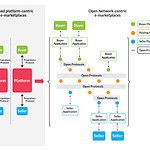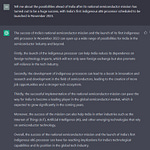Siliconpolitik: India and Taiwan Want to Complement Each Other’s Strengths
— Arjun Gargeyas
There were reports earlier this month that Indian and Taiwanese officials had met to discuss the possibility of a $7.5 billion investment in India by the Taiwanese government and its premier semiconductor foundry, Taiwan Semiconductor Manufacturing Company (TSMC). This was to set up a long-pending state-of-the-art semiconductor manufacturing facility in the country. While India has been strong at semiconductor IC design, it has also made efforts to create a presence in fabrication. Taiwan, on the other world, dominates the semiconductor manufacturing market, with two of its major companies, TSMC and UMC, jointly accounting for over 60% of the global revenue in manufacturing and fabrication. With Taiwan’s presence in the semiconductor IC design also growing gradually with companies like MediaTek looking to challenge the fabless American firms, the Indian semiconductor fraternity’s experience in the design cycle is attractive for Taiwanese design firms looking to upscale their operations.
Semiconductor manufacturing has been at the heart of a possible technology alliance between the two states. However, with both India and Taiwan having their own comparative advantages in the semiconductor industry, there is significant potential for collaboration in other areas of the semiconductor supply chain.
Research and Development: The government of India has, for a long time, envisioned setting up a semiconductor fabrication facility in the country that can indulge in cutting-edge research. Its attempt started way back in the 1980s with the establishment of the Semiconductor Company Limited (SCL). But a major fire and sluggish innovation have now restricted SCL to research in specific fields like space technology. Taiwan’s semiconductor success story lies in its consistent investments, funded by the Taiwanese government itself in research and development to improve semiconductor manufacturing processes. India and Taiwan should look to invest in an R&D center that can bring together both semiconductor firms and universities from both states.
Design: Though Taiwan’s stranglehold over the semiconductor industry originates from its ‘Pure Play Foundry’ business model focusing on manufacturing semiconductors for its clients, the IC design ecosystem in the country has gradually grown, dominated by firms like MediaTek. However, these semiconductor design firms indulge in the low-cost design of trailing edge nodes as an alternative to the Western companies’ products. The major market for Taiwanese design firms remains the Chinese mainland. With relations deteriorating between the two countries, Taiwanese firms will look at alternative markets. India, with its ever-increasing demand for high technology products, can step into the role. A thriving semiconductor design services market in the country can also help Taiwanese firms reach the level of American firms with the Indian workforce’s expertise in the field.
Assembly and Testing: While India’s ambitions to invest in a semiconductor fabrication facility are commendable, the costs associated with semiconductor manufacturing remain very high. Exorbitant equipment costs and the need to pump in investments regularly can hamper India’s plan to become a major player in the foundry business. Instead, India, which has already gained expertise in downstream assembly and testing processes can look at Outsourced Assembly and Test (OSAT) opportunities. With low-skilled labor only needed, unlike semiconductor manufacturing, India can serve as a source of low cost and low skilled labor for Taiwanese firms like ASE Technology and Powertech Technology, which look to outsource such operations offshore. The Indian government’s Ministry of Electronics and Information Technology (MeitY) has also released schemes like SPECS to attract foreign firms for OSAT operations. The Scheme for Promotion of Manufacturing of Electronic Components and Semiconductors (SPECS) will provide a financial incentive of 25% on capital expenditure for the identified list of electronic goods that comprise downstream value chain of electronic products, i.e., electronic components, semiconductor/ display fabrication units, ATMP units, specialized sub-assemblies and capital goods for manufacture of aforesaid goods, all of which involve high value-added manufacturing.
India and Taiwan’s technology trade has gradually increased in the last two decades. With increasing technological cooperation between the two countries, the semiconductor industry, and both their complementary strengths in it offer a great opportunity for better collaboration in the domain. This can cover a wide area in the supply chain, going beyond just the talk on semiconductor manufacturing and fabrication facilities.
If you enjoy the contents of this newsletter consider reading and subscribing to China Tech Dispatch for weekly updates on China’s military and civilian tech sectors.
Yogakshema: Is it Worth Debating Responsible Behaviour in Cyberspace and Outer Space?
— Aditya Pareek
The Japanese Defence Minister Nobuo Kishi recently remarked that
"An invasion may begin without anyone realizing it, and a war may be fought without the use of military forces."
The challenges Kishi alludes to are aggravated when taking hightech domains like cyberspace and outer space into account. There is a lot of shadowy, hard-to-attribute activity associated with rendezvous and proximity operations(RPO)s in outer space as well as in cyber attacks. With near misses in outer space and major attacks against infrastructure and finances via the use of cyberspace, a lot of finger pointing between states ensues.
There is a multilateral push for figuring out rules of the road or more formally, to establish some mechanism to set norms for responsible behaviour in cyberspace and outer space. Two draft resolutions have been submitted to the UN General Assembly’s First Committee that try to address these topics. The first is earmarked as agenda item 95 titled
“Developments in the field of information and telecommunications in the context of international security, and advancing responsible State behaviour in the use of information and communications technologies”.
The second is earmarked as agenda item 98 (d)
“Prevention of an arms race in outer space: reducing space threats through norms, rules and principles of responsible behaviours”.
India and China are both absent from the list of sponsors of both resolutions for the moment, but this may change as the time nears for the UNGA to take a general votes on the resolutions.
At first glance the subject and titles of the two draft resolutions might seem to be signalling some sort of consensus emerging in the UNGA simultaneously over norms of responsible behaviour in cyberspace and outer space. However, on closer study, the two draft resolutions are reflective of the same tense international relationships which are the cause for friction in these domains in the first place.
On the draft dealing with cybersapce, as Elena Chernenko of Kommersant (a Russian business media outlet) points out in her reporting,
The development of a joint draft document by Russia and the United States can be considered an important event, if only because in recent years the two countries have often acted in the UN as rivals or even adversaries. And the subject of cybersecurity, until recently, was no exception in this regard.
As expected of a document prepared as a compromise between geopolitical adversaries, it features very amenable language while clearly highlighting that its contents are aimed at “voluntary, non-binding norms” which “do not seek to limit or prohibit action that is otherwise consistent with international law” in cyberspace.
The draft dealing with responsible behaviour in outer space features sponsors countries that enjoy good relations with the US. Some of these sponsors are lesser adversaries in their own right to Russia, like the United Kingdom and Poland.
The draft notably has several references to “a combination of legally binding obligations and political commitments” as being essential on issues ranging from “instruments on the prevention of an arms race in outer space” to a more broadly focused issue of “space security”.
These references to legally binding obligations will likely dissuade a lot of state including some major powers that prefer to achieve their political goals via the use of asymmetric means.
If a consensus is not likely and some major powers will continue to keep their options open, then the whole point of the resolutions becomes moot. Whatever toothless guidelines the resolutions incorporate will be ignored and worse may even be flouted, degrading the momentum and credibility of the international efforts that went in the drafting of these resolutions.
Cyberpolitik: Going Meta
— Sapni G K
Mired in controversy and bad press, the Facebook Company has been having some of the worst days of its existence. The last couple of months saw it facing suits that pushed for breaking up the company to whistle-blower revelations which contradicted multiple positions it took while addressing allegations raised against it. Amidst these serious allegations, it has also been trying to reinvent itself to attract and retain more users on its various platforms. After weeks of conversations led by CEO Mark Zuckerberg on the metaverse, the company has found a home in that idea to find a better future for itself.
The term "metaverse" has its origins in Snow Crash, the 1992 dystopian science fiction novel by Neal Stephenson ( who clarified that he has got nothing do with the company). The book envisions metaverse as a full-fledged alternate reality built in a virtual space. Life is brutal on the metaverse, but it is worse in Snow Crash's real world. This virtual escape fuelled further science fiction writing on the idea, now culminating in the world's largest social media company changing its name to " Meta" to reflect its interest in building the metaverse future. Meta now holds the range of apps such as Facebook, Instagram, WhatsApp, and technologies such as Oculus.
In the keynote introducing Meta, Zuckerberg outlined his vision for the metaverse as a space different from the siloed worlds created by the social media age. He sees it as a collection of protocols that are interoperable and not owned by one company. Here users can jump into the virtual to connect with others and have experiences in different worlds. Meta is not pioneering the idea. Epic Games and Roblox have already created similar worlds, where some failed decades ago. However, it is trying to shift the status quo from today's walled gardens to open protocols. This is a huge leap in Meta's ethos (RIP the Facebook Company) which rallied ahead by creating siloed spaces. It is also reflective of how our platformised lives are moving further towards gamification.
Critics and industry observers have called this a gimmick to divert attention from the pressing issues raised against the company. Even if that were the case, changing the name of the company will do little to save it from public ire and demands for addressing these concerns better. However, it is worth noting this change in priorities as we continue to look to fix the problems in the social media platforms. While Zuckerberg proclaimed that 'since the Metaverse isn't here yet, this offers a chance for policymakers to stop playing catch up with technology but direct its development and regulation', Meta would not be the desirable choice for many to drive this change. Its shady track record in norm-setting on platform governance only exacerbates worries.
For India, this change might currently have no visible difference. Access to today's Metaverse is limited, mostly through expensive VR headsets. The penetration of such technologies in India is limited, though growing. However, learning from the smartphone boom, India could see this as an opportunity to amp up the capabilities in manufacturing of the devices and development of software that are necessary for interacting in the metaverse. The manufacturing and design economies can gain from this. A thriving design and manufacturing economy could also have knock-on effects creating more professionals who understand the functioning of the "metaverse" better. Finally, it can give India a seat on the table in virtual reality/metaverse regulation and policymaking, which in current nascent stages in restricted to China, the EU and, the USA.
Yogakshema: Hyperbole Over Hypersonics
— Aditya Ramanathan
In a television interview on 27 October, the chairman of the US Joint Chiefs of Staff, General Mark A. Milley acknowledged reports of recent Chinese tests of hypersonic weapons. Presumably seeking to strike a balance between underplaying and overplaying the significance of the tests, Milley described them as “a very significant event,” adding that “I don’t know if it's quite a Sputnik moment but I think it’s very close to that.”
The cliche of a “Sputnik moment” refers to the dawn of the space age. The Soviet launch of the world’s first artificial satellite, on 4 October 1957, sparked fears in the US that it was being left behind, and spurred its own space programme. In the years since, politicians have used the phrase to evoke the sense of a much-needed wake-up call for the US . President Barack Obama called the recession of 2008-09 a “Sputnik moment” and Senator John Kerry used the term in the context of clean energy technology. Roger Launius, senior curator of the NASA museum’s space history division summarised the parable of the “Sputnik moment” the best:
"A Sputnik moment is a trigger mechanism, an event that makes people collectively say that they need to do something, and this sets a course in another direction".
Are China’s new capabilities significant enough for the US to rejig its defence priorities? Not quite.
The Hypersonic Rationale: Let’s begin by trying to understand what exactly it was that China tested in July and August of this year. On 21 October, The Financial Times reported that China used a Long March rocket to launch a “fractional orbital bombardment” system that, in turn, carried a hypersonic glide vehicle.
The Soviets experimented with fractional orbital bombardment systems (FOBS) in the 1960s. The broad idea of FOBS was to evade US early warning systems that were largely focused towards the North Pole. It would achieve this by launching a craft that would only complete a partial orbit before de-orbiting and plunging towards its target on Earth. Theoretically, a FOBS system would allow the Soviets to attack the US via the South Pole, and achieve complete surprise. The Soviets deployed small numbers of such systems for about two decades during the Cold War.
That leaves us with hypersonic boost glide vehicles. While regular long-range ballistic missiles such as ICBMS use space as a rapid-transit zone to reach distant spots on Earth, boost glides fly at much flatter trajectories, below the 100-kilometre that marks the boundary between the upper atmosphere and space. The key advantages of boost-glides are that their flatter trajectories allow them to hide behind the Earth’s curvature for longer periods (thus delaying detection) and that navigation technologies allow them to manoeuvre unpredictably on their approach to a target, possibly making interception even harder.
So why is China developing such systems? The short answer is the US ballistic missile defence (BMD) programme. And China is not alone in this effort. In 2018, Russia unveiled a series of experimental systems designed specifically to evade US ballistic missile defences. These included a long-range ballistic missile that could approach the continental United States via the South Pole as well as a cruise missile with a nuclear-powered engine that would give it unprecedented range.
If the Russians and Chinese are resorting to such exotic weapons, we must ask two questions. One, are they the only solution for tackling US BMD? And two, do hypersonic boost glides have problems of their own?
The Uncertain Glory of BMD: The current US BMD programme has its origins in 2002, when the country withdrew from the 1972 Anti-Ballistic Missile (ABM) Treaty. The political pretext for this move was the 9/11 attacks. The technological rationale was the revolution in sensory and computing technology that allowed for far more accurate tracking and targeting of incoming missiles. Some also argue that US BMDs also continue to provide it with negotiating leverage in any future arms control talks.
However, while US BMDs are far more effective today than they were even a decade ago, they still face two fundamental obstacles: they have at best a 50% chance of successfully intercepting a ballistic missile, and they’re far more expensive. In short, BMDs are expensive and only partially effective. US BMDs are not meant to defend against a full-fledged attack by another state; they’re only meant to stop stray missiles, either from a rogue launch or from the remnants of an adversary’s nuclear arsenal after most of it has been destroyed. The reality is that an arsenal of regular ICBMs, each with bristling with multiple independently targetable re-entry vehicles (MIRVs) and decoys is more than a match for BMDs. Exotic weapons like boost-glides are at best an augmentation to existing capabilities.
The Limited Advantages of FOBS and Boost Glides: While FOBS and boost-glides may have their place, there’s a reason why the USSR did not rely heavily on such systems during the Cold War. FOBS weapons need a small rocket to de-orbit, meaning a reduced payload. And today’s boost-glides can carry only a single warhead. Therefore, a combined FOBS-boost glide system will only carry a single, relatively small warhead. Also, since boost-glides actually travel at lower speeds than ICBM warheads on re-entry, they may actually become easier to intercept in the future.
The Prospects: Nothing is settled in the matter of long-range missiles. New developments could make boost glides and FOBS more accurate and capable of delivering greater payloads. BMD systems could also become more effective in the future. As of now, however, we must acknowledge that whatever China tested earlier this year, was probably not revolutionary, and hardly amounts to a Sputnik moment.
Our Reading Menu
[Opinon] Facebook and YouTube’s vaccine misinformation problem is simpler than it seems by Will Oremus on Wahsington Post
[Opinons] Why Facebook has become Meta on Financial Times by Hannah Murphy and Madhumita Murgia
[Book] Tiger Technology: The Creation of a Semiconductor Industry in East Asia
[Article] Russia, China, The US: Who will win the Hypersonic Arms Race?
[Paper] Outer Space and Cyberspace: A Tale of Two Security Realms









